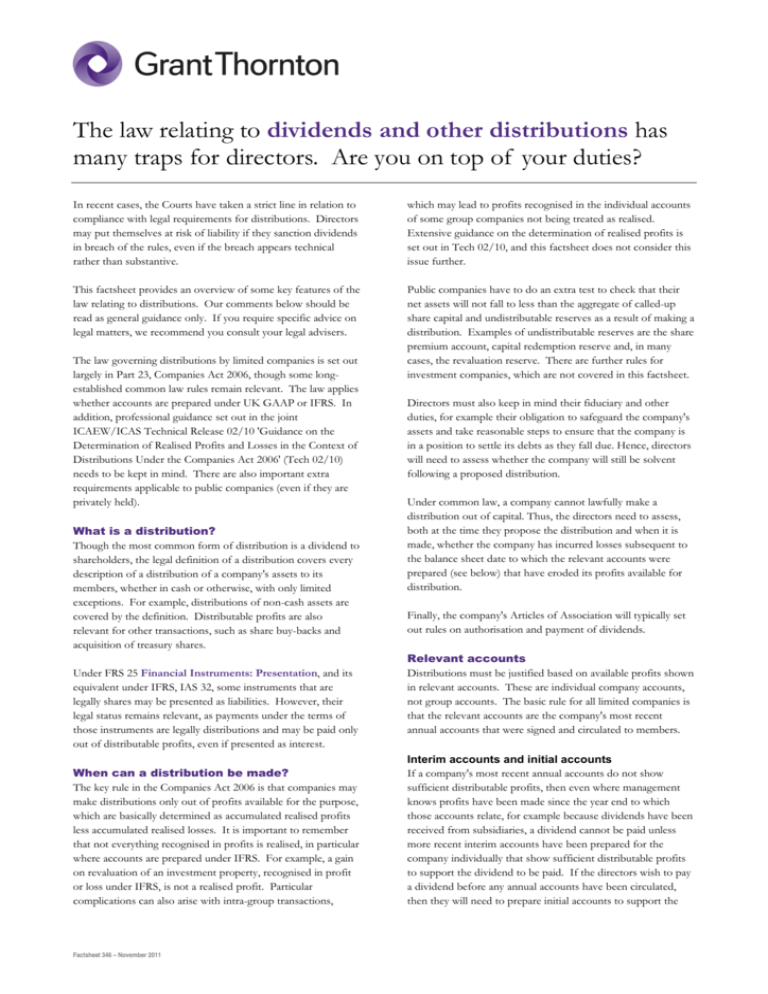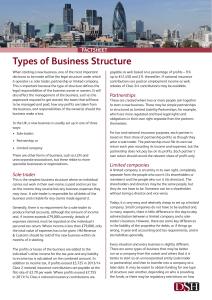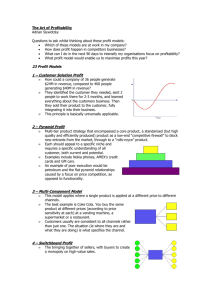
The law relating to dividends and other distributions has
many traps for directors. Are you on top of your duties?
In recent cases, the Courts have taken a strict line in relation to
compliance with legal requirements for distributions. Directors
may put themselves at risk of liability if they sanction dividends
in breach of the rules, even if the breach appears technical
rather than substantive.
which may lead to profits recognised in the individual accounts
of some group companies not being treated as realised.
Extensive guidance on the determination of realised profits is
set out in Tech 02/10, and this factsheet does not consider this
issue further.
This factsheet provides an overview of some key features of the
law relating to distributions. Our comments below should be
read as general guidance only. If you require specific advice on
legal matters, we recommend you consult your legal advisers.
Public companies have to do an extra test to check that their
net assets will not fall to less than the aggregate of called-up
share capital and undistributable reserves as a result of making a
distribution. Examples of undistributable reserves are the share
premium account, capital redemption reserve and, in many
cases, the revaluation reserve. There are further rules for
investment companies, which are not covered in this factsheet.
The law governing distributions by limited companies is set out
largely in Part 23, Companies Act 2006, though some longestablished common law rules remain relevant. The law applies
whether accounts are prepared under UK GAAP or IFRS. In
addition, professional guidance set out in the joint
ICAEW/ICAS Technical Release 02/10 'Guidance on the
Determination of Realised Profits and Losses in the Context of
Distributions Under the Companies Act 2006' (Tech 02/10)
needs to be kept in mind. There are also important extra
requirements applicable to public companies (even if they are
privately held).
What is a distribution?
Though the most common form of distribution is a dividend to
shareholders, the legal definition of a distribution covers every
description of a distribution of a company's assets to its
members, whether in cash or otherwise, with only limited
exceptions. For example, distributions of non-cash assets are
covered by the definition. Distributable profits are also
relevant for other transactions, such as share buy-backs and
acquisition of treasury shares.
Under FRS 25 Financial Instruments: Presentation, and its
equivalent under IFRS, IAS 32, some instruments that are
legally shares may be presented as liabilities. However, their
legal status remains relevant, as payments under the terms of
those instruments are legally distributions and may be paid only
out of distributable profits, even if presented as interest.
When can a distribution be made?
The key rule in the Companies Act 2006 is that companies may
make distributions only out of profits available for the purpose,
which are basically determined as accumulated realised profits
less accumulated realised losses. It is important to remember
that not everything recognised in profits is realised, in particular
where accounts are prepared under IFRS. For example, a gain
on revaluation of an investment property, recognised in profit
or loss under IFRS, is not a realised profit. Particular
complications can also arise with intra-group transactions,
Factsheet 346 – November 2011
Directors must also keep in mind their fiduciary and other
duties, for example their obligation to safeguard the company's
assets and take reasonable steps to ensure that the company is
in a position to settle its debts as they fall due. Hence, directors
will need to assess whether the company will still be solvent
following a proposed distribution.
Under common law, a company cannot lawfully make a
distribution out of capital. Thus, the directors need to assess,
both at the time they propose the distribution and when it is
made, whether the company has incurred losses subsequent to
the balance sheet date to which the relevant accounts were
prepared (see below) that have eroded its profits available for
distribution.
Finally, the company's Articles of Association will typically set
out rules on authorisation and payment of dividends.
Relevant accounts
Distributions must be justified based on available profits shown
in relevant accounts. These are individual company accounts,
not group accounts. The basic rule for all limited companies is
that the relevant accounts are the company's most recent
annual accounts that were signed and circulated to members.
Interim accounts and initial accounts
If a company's most recent annual accounts do not show
sufficient distributable profits, then even where management
knows profits have been made since the year end to which
those accounts relate, for example because dividends have been
received from subsidiaries, a dividend cannot be paid unless
more recent interim accounts have been prepared for the
company individually that show sufficient distributable profits
to support the dividend to be paid. If the directors wish to pay
a dividend before any annual accounts have been circulated,
then they will need to prepare initial accounts to support the
proposed dividend. This situation typically arises where the
company is newly incorporated.
vendor company. The Court held that this amounted to an
unlawful return of capital.
For a private company, these interim and initial accounts need
to be sufficient for the directors to make a reasonable
judgement as to profits, losses, assets and liabilities, provisions,
and share capital and reserves. There is no filing requirement.
The Explanatory Notes issued by the then Department of
Trade and Industry alongside the Companies Act 2006 made it
clear that section 845, Companies Act 2006, did not disturb the
position in the Aveling Barford case, rather it clarified wider
issues arising. The UK Supreme Court considered the issue
further in 2010 in the case of Progress Property Company Limited v
Moorgarth Group Limited. They noted that the validity of a
distribution should be determined by considering the true
purpose and substance of the transaction rather than the form.
For a public company, the rules are much stricter. Interim
accounts must be properly prepared under the Companies Act
2006 (save for areas not material to the proposed distribution)
and filed at Companies House prior to making the distribution.
However, these interim accounts need not be audited. By
contrast, if a public company needs initial accounts to justify a
dividend, those accounts do need to be audited. In most other
respects, the requirements for initial accounts are similar to
those for interim accounts, including the need to file the
accounts at Companies House prior to paying the dividend.
Distributions in kind
In addition to paying dividends in cash, distributions in kind are
also covered by legal requirements. A distribution in kind is a
distribution consisting of or including, or treated as arising in
consequence of, the sale, transfer or other disposition by a
company of a non-cash asset. For example, a waiver of an
amount receivable from a parent is considered a distribution as
it is an "other disposition" of that receivable.
The rules governing distributions in kind are a key issue in
group situations where assets are transferred from subsidiary to
parent or subsidiary to fellow subsidiary. They are also
important when assets are sold to shareholders or companies
under their control. The key question is whether the transferor
company has distributable profits.
Transferor company has distributable profits
If the transferor company has any distributable profits at all,
even as little as £1, then under section 845, Companies Act
2006, it can transfer assets for consideration at least equal to
book value, even if that is less than fair value. Where assets are
carried at revalued amounts, further statutory rules apply. If the
transfer is to be made for consideration less than book value
(or nil), then any shortfall in consideration compared to book
value must be covered by distributable profits.
Transferor company has no distributable profits
If the transferor company has no distributable profits, then the
directors are at risk of being liable for an unlawful return of
capital unless the transfer is made for consideration at least
equal to the fair value of the asset being transferred. The
leading case on this issue was that of Aveling Barford Ltd v
Perion Ltd (1989) where a property was sold for significantly less
than its fair value by a company with accumulated losses to
another company owned by the controlling shareholder of the
One implication of the Progress Property case is that the mere
fact that an asset is disposed of at undervalue (in situations not
allowed for by Companies Act 2006) does not mean that there
will necessarily have been an unlawful return of capital.
However, the relevant facts of a particular case taken as a whole
may indicate that there has been. Hence, it is advisable for
directors to obtain legal advice at an early stage if they are in
any doubt about the propriety of a proposed transaction.
Directors are at risk
Management may consider that not filing relevant accounts or
otherwise not complying strictly with the law is simply a
procedural irregularity if they know that there are sufficient
profits in the group. However, the case of Bairstow v Queen's
Moat Houses plc (2001) is an example of where the directors were
found liable by the Court for being in breach of duty relating to
making distributions even though profits existed in the group.
In the Progress Property case, the Supreme Court stated that a
dividend paid out of capital is unlawful, however technical the
error and however well-meaning the directors who paid it. This
means that the directors are exposed to liability if they sanction
dividends where the legal requirements have not been met.
The consequences of an unlawful distribution are severe, as it
cannot simply be ratified by the shareholders retrospectively.
Shareholders who receive an unlawful distribution may be liable
to repay it or repay equivalent value, eg where the distribution is
of a non-cash asset. The directors may also find themselves in
breach of their duties and be held liable.
Any questions?
This factsheet can serve only as an introduction to some of the
issues raised by the law on distributions. These requirements
differ between private and public companies, and are
significantly tighter for the latter. If you wish to discuss these
issues further, then please contact your usual Grant Thornton
representative to discuss how we can help you address these
requirements. Alternatively, please contact our office location
nearest to you for assistance, which can be found on our
website at www.grant-thornton.co.uk.
© Grant Thornton UK LLP 2011. All rights reserved.
‘Grant Thornton’ means Grant Thornton UK LLP, a limited liability partnership.
Grant Thornton UK LLP is a member firm of Grant Thornton International Ltd (‘Grant Thornton International’).
Grant Thornton International and the member firms are not a worldwide partnership. Services are delivered by the member firms independently.
This publication has been prepared only as a guide. No responsibility can be accepted by us for loss occasioned to any person acting or refraining from acting as a result of any material in this publication.
www.grant-thornton.co.uk







